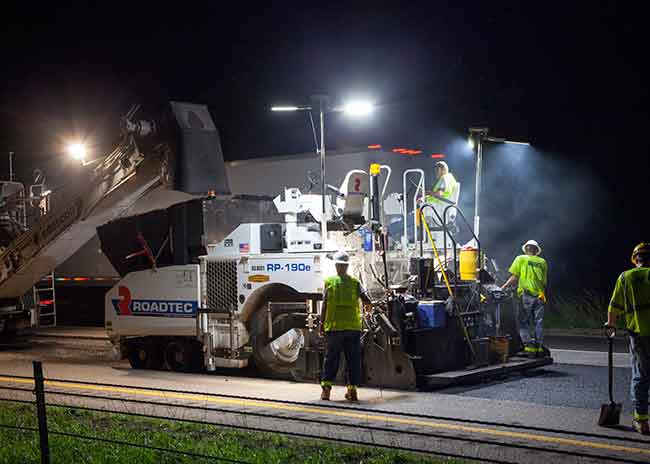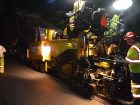
Features
Roads & Paving
Technology
Safer Night Work
New trends in safety and illumination
October 14, 2015 By Travis Colwell

Roadway construction zones are dangerous by their nature. Add in the element of night and suddenly the traditional hazards of roadway work zones are joined with low visibility and a higher rate of impaired or distracted drivers.
As more projects are scheduled for night to alleviate motorist congestion, especially in urban areas or highly traveled roadways, contractors have to plan more illumination to reduce the hazards and increase overall safety of their work zones.
With the rise of Light Emitting Diode (LED) technology, increased mobile equipment lighting and the recognition of glare, contractors should be informed of the changes and trends in the industry to make the right decisions on their future lighting purchases.
The Rise of LED’s
Perhaps the most exciting advancement in work zone illumination and safety has been the emergence of LEDs as a high intensity light source. While the halogen light has long been the lighting source for work zones, LED lighting platforms have begun to challenge the halogen’s supremacy with LEDs emerging in factory installed equipment lighting, mobile equipment lighting and mobile light towers.
“It’s a really exciting field right now,” exclaims Mike Bauman, chief technology officer for LiteGear, a California-based company that specializes in LED cinematic and industrial lighting. “LED lighting is much more efficient and usually results in an 80 per cent reduction in energy use.” Not only do such platforms offer energy savings, Bauman adds, when properly designed LEDs can increase a contractor’s return on investment as LED platforms can be more robust and able to withstand extreme environments, temperatures and handling.
While energy efficiency and ruggedness offer contractors considerable advantages over halogens, it is the high output of LED platforms that is helping to create safer work zones. “Over the past three years there have been large advances in efficacy: the amount of light output per watt,” Bauman explains. “This has allowed the LED to really compete against traditional halogen sources.”
With the ability of matching or surpassing halogen illumination output, LED lights are able to brilliantly and effectively illuminate work zones and worker positions. An added safety feature of the platforms is the ability of manufacturers to tune the light spectrum to a more natural color spectrum. Creating light more comfortable to the eyes, LEDs are able to enhance object recognition of workers and motorists alike.
LED lights have quickly gained ground, but as with most new technology, the price point of such systems continues to be higher than halogen systems. Contractors should examine the overall costs, both in the short term and in regards to return on investment over the lifecycle of the platform, when selecting the right lighting source for their illumination needs.
Illuminating Mobile Equipment
Reflecting the shift in the industry towards an increase in scheduled night projects, manufacturers have begun to design and build mobile equipment with more integrated lights to enhance illumination on and around the machine. While not new on mobile equipment, integrated lighting systems have begun to emerge in greater numbers as standard equipment or economical options on many platforms of major manufacturers.
A major reason behind the rise of integrated lighting systems on mobile equipment has been to combat one of the leading causes of injury and fatality on night projects: lack of visibility around machines. For operators, workers and motorists, low visibility and shadows around mobile equipment can create hazardous conditions. While flood lighting on the jobsite does help cut down on these, integrated lighting systems on mobile machinery helps eliminate shadows around the machines and gives operators especially clear visibility.
A wide variety of lighting sources are offered for mobile equipment including high output LEDs, halogens and high-intensity discharge (HID) lights. LED and HID lights are increasingly being used due to their long lifecycles, robust reliability and high outputs that produce direct light on specific areas around the machines.
But while these lights offer safer working environments around equipment with their high light output, contractors need to be mindful of glare produced. When selecting lights for mobile equipment or looking at platforms with integrated systems, contractors should look at the adjustability of such illumination sources as these lights can create disabling glare to workers and oncoming motorists.
Confronting Dangerous Glare
For work zone crews, night time projects pose elevated risks of safety especially when taking into account oncoming motorists. This is due in part to the increasing amount of distractions within vehicles nowadays and the traditional levels of impaired drivers during evening and night hours. Yet a major factor of risk is due to our eyes and how they are able to adapt to lighting levels at night.
Not only does the human eye lose depth perception as the level of light diminishes, but dilation of the pupils plays a major factor in our ability to make out shapes and see at low light levels. When an eye is accustomed to low light levels and intense light is introduced, such as from a HID light, the pupil dilates. The pupil then takes time to readjust back to the lower light levels, thus affecting overall vision and shape recognition. As we age that readjustment time lengthens. Taking into account the aging population of Canada, glare becomes a pressing issue for ensuring safer nighttime construction zones.
In many ways then, work zone lighting is like a balancing act in getting the right amount of illumination while being mindful of glare produced. Manufacturers are taking this problem seriously by introducing more low profile lighting systems and directional illumination. When looking at platforms to invest in, be mindful of how much glare the system will produce and how the system can be integrated into your lighting plan.
With many manufacturers of lighting systems offering safer and brighter platforms, contractors are able to shop for the best price and best platform to suit their work zone needs and increase the overall safety of Canada’s ever-growing night scheduled construction work.
Travis Colwell is the head of marketing and corporate communications for Carlson Paving Products. The preceding article was written exclusively for Rock to Road magazine.
Print this page

